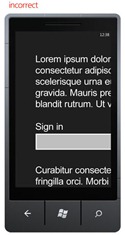Conventional web pages are rarely optimized to be viewed on phones. , That’s why pinch and zoom is enabled when we browse those web on phones. The ability to enlarge web content is a behavior we expect when we use a mobile browser, however when we interact with a mobile app that expectation is no longer true. So, take caution when embedding web content in your application. However, if you must do this, then follow these precautions: and lists five situations to avoid when doing it.
· Text size should still be the minimum required for WP7, 15 points
· Input fields should be at the right size, tapping to enlarge them and fitting the screen is not expected by the user
· The opposite behavior should be avoided. , Content going beyond the screen could be mistakenly viewed as part of a panoramic experience instead content that should be pinched to be fitting the screen.
· The user doesn’t know if your content is pulled from a web site or is part of the app, therefore don’t assume will interact with it as if it was displayed on a web browser, pinching and zooming will be a surprise, not the expected behavior.
· Make sure links and color palette match the rest of the application. You probably don’t have blue underlined text on your app and landing on a page that does it will confuse the user and break the needed consistency.
Simply embedding existing web content without considering the above points will create a poor experience as the content will behave unexpectedly and will not be viewed properly and consistently, breaking a successful, mobile optimized experience.
– Alfred Astort
Follow the Windows Phone Design Team on Twitter: @WPdesignteam

